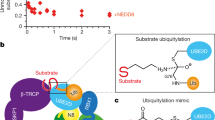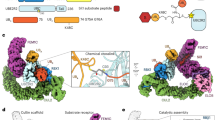Abstract
Cullin family proteins organize ubiquitin ligase (E3) complexes to target numerous cellular proteins for proteasomal degradation. Neddylation, the process that conjugates the ubiquitin-like polypeptide Nedd8 to the conserved lysines of cullins, is essential for in vivo cullin-organized E3 activities1,2. Deneddylation, which removes the Nedd8 moiety, requires the isopeptidase activity of the COP9 signalosome (CSN)3,4. Here we show that in cells deficient for CSN activity, cullin1 (Cul1) and cullin3 (Cul3) proteins are unstable, and that to preserve their normal cellular levels, CSN isopeptidase activity is required. We further show that neddylated Cul1 and Cul3 are unstable — as suggested by the evidence that Nedd8 promotes the instability of both cullins — and that the unneddylatable forms of cullins are stable. The protein stability of Nedd8 is also subject to CSN regulation and this regulation depends on its cullin-conjugating ability, suggesting that Nedd8-conjugated cullins are degraded en bloc. We propose that while Nedd8 promotes cullin activation through neddylation, neddylation also renders cullins unstable. Thus, CSN deneddylation recycles the unstable, neddylated cullins into stable, unneddylated ones, and promotes cullin-organized E3 activity in vivo.
This is a preview of subscription content, access via your institution
Access options
Subscribe to this journal
Receive 12 print issues and online access
$209.00 per year
only $17.42 per issue
Buy this article
- Purchase on Springer Link
- Instant access to full article PDF
Prices may be subject to local taxes which are calculated during checkout





Similar content being viewed by others
References
Ou, C. Y., Lin, Y. F., Chen, Y. J. & Chien, C. T. Distinct protein degradation mechanisms mediated by Cul1 and Cul3 controlling Ci stability in Drosophila eye development. Genes Dev. 16, 2403–2414 (2002).
Pintard, L. et al. Neddylation and deneddylation of CUL-3 is required to target MEI-1/Katanin for degradation at the meiosis-to-mitosis transition in C. elegans. Curr. Biol. 13, 911–921 (2003).
Lyapina, S. et al. Promotion of NEDD-CUL1 conjugate cleavage by COP9 signalosome. Science 292, 1382–1385 (2001).
Zhou, C. et al. The fission yeast COP9/signalosome is involved in cullin modification by ubiquitin-related Ned8p. BMC Biochem. 2, 7 (2001).
Petroski, M. D. & Deshaies, R. J. Function and regulation of cullin-RING ubiquitin ligases. Nature Rev. Mol. Cell Biol. 6, 9–20 (2005).
Willems, A. R., Schwab, M. & Tyers, M. A hitchhiker's guide to the cullin ubiquitin ligases: SCF and its kin. Biochim. Biophys. Acta 1695, 133–170 (2004).
Kamura, T., Conrad, M. N., Yan, Q., Conaway, R. C. & Conaway, J. W. The Rbx1 subunit of SCF and VHL E3 ubiquitin ligase activates Rub1 modification of cullins Cdc53 and Cul2. Genes Dev. 13, 2928–2933 (1999).
Hori, T. et al. Covalent modification of all members of human cullin family proteins by NEDD8. Oncogene 18, 6829–6834 (1999).
Pan, Z. Q., Kentsis, A., Dias, D. C., Yamoah, K. & Wu, K. Nedd8 on cullin: building an expressway to protein destruction. Oncogene 23, 1985–1997 (2004).
Wu, K., Chen, A. & Pan, Z. Q. Conjugation of Nedd8 to CUL1 enhances the ability of the ROC1-CUL1 complex to promote ubiquitin polymerization. J. Biol. Chem. 275, 32317–32324 (2000).
Kawakami, T. et al. NEDD8 recruits E2-ubiquitin to SCF E3 ligase. EMBO J. 20, 4003–4012 (2001).
Pintard, L. et al. The BTB protein MEL-26 is a substrate-specific adaptor of the CUL-3 ubiquitin-ligase. Nature 425, 311–316 (2003).
Geyer, R., Wee, S., Anderson, S., Yates, J. & Wolf, D. A. BTB/POZ domain proteins are putative substrate adaptors for cullin 3 ubiquitin ligases. Mol. Cell 12, 783–790 (2003).
Wei, N. & Deng, X. W. The COP9 signalosome. Annu. Rev. Cell Dev. Biol. 19, 261–286 (2003).
Cope, G. A. et al. Role of predicted metalloprotease motif of Jab1/Csn5 in cleavage of Nedd8 from Cul1. Science 298, 608–611 (2002).
Gusmaroli, G., Feng, S. & Deng, X. W. The Arabidopsis CSN5A and CSN5B subunits are present in distinct COP9 signalosome complexes, and mutations in their JAMM domains exhibit differential dominant negative effects on development. Plant Cell 16, 2984–3001 (2004).
Dohmann, E. M., Kuhnle, C. & Schwechheimer, C. Loss of the CONSTITUTIVE PHOTOMORPHOGENIC9 signalosome subunit 5 is sufficient to cause the cop/det/fus mutant phenotype in Arabidopsis. Plant Cell 17, 1967–1978 (2005).
Doronkin, S., Djagaeva, I. & Beckendorf, S. K. The COP9 signalosome promotes degradation of Cyclin E during early Drosophila oogenesis. Dev. Cell 4, 699–710 (2003).
Wee, S., Geyer, R. K., Toda, T. & Wolf, D. A. CSN facilitates Cullin–RING ubiquitin ligase function by counteracting autocatalytic adapter instability. Nature Cell Biol. 7, 387–391 (2005).
Cope, G. A. & Deshaies, R. J. COP9 signalosome: a multifunctional regulator of SCF and other cullin-based ubiquitin ligases. Cell 114, 663–671 (2003).
Wolf, D. A., Zhou, C. & Wee, S. The COP9 signalosome: an assembly and maintenance platform for cullin ubiquitin ligases? Nature Cell Biol. 5, 1029–1033 (2003).
von Arnim, A. G. On again-off again: COP9 signalosome turns the key on protein degradation. Curr. Opin. Plant Biol. 6, 520–529 (2003).
Oron, E. et al. COP9 signalosome subunits 4 and 5 regulate multiple pleiotropic pathways in Drosophila melanogaster. Development 129, 4399–4409 (2002).
Uhle, S. et al. Protein kinase CK2 and protein kinase D are associated with the COP9 signalosome. EMBO J. 22, 1302–1312 (2003).
Zhou, C. et al. Fission yeast COP9/signalosome suppresses cullin activity through recruitment of the deubiquitylating enzyme Ubp12p. Mol. Cell 11, 927–938 (2003).
Groisman, R. et al. The ubiquitin ligase activity in the DDB2 and CSA complexes is differentially regulated by the COP9 signalosome in response to DNA damage. Cell 113, 357–367 (2003).
He, Q., Cheng, P. & Liu, Y. The COP9 signalosome regulates the Neurospora circadian clock by controlling the stability of the SCFFWD-1 complex. Genes Dev. 19, 1518–1531 (2005).
Doronkin, S., Djagaeva, I. & Beckendorf, S. K. CSN5/Jab1 mutations affect axis formation in the Drosophila oocyte by activating a meiotic checkpoint. Development 129, 5053–5064 (2002).
Worby, C. A., Simonson-Leff, N. & Dixon, J. E. RNA interference of gene expression (RNAi) in cultured Drosophila cells. Sci. STKE 2001, pl1 (2001).
Chen, C. K. & Chien, C. T. Negative regulation of atonal in proneural cluster formation of Drosophila R8 photoreceptors. Proc. Natl Acad. Sci. USA 96, 5055–5060 (1999).
Acknowledgements
The authors thank S. K. Beckendorf, D. A. Chamovitz, G. Cope, R. Desheias and D. Segal for reagents and fly stocks; S. K. Huang and Y. R. Chan for generating the Nedd8 transgenic stocks; K. Deen for editing work; and E. Chang, S. I. Jang, C. H. Lee, T. P. Yao and lab members for helpful comments and discussions. This work was supported by National Science Council, National Health Research Institute, and Academia Sinica of Taiwan to C.T.C. and NHRI MD PhD/DDS PhD Predoctoral Fellowship DD9307N to J.T.W.
Author information
Authors and Affiliations
Corresponding author
Ethics declarations
Competing interests
The authors declare no competing financial interests.
Supplementary information
Supplementary Information
Supplementary figures S1, S2, S3, S4 and supplementary table S1 (PDF 315 kb)
Rights and permissions
About this article
Cite this article
Wu, JT., Lin, HC., Hu, YC. et al. Neddylation and deneddylation regulate Cul1 and Cul3 protein accumulation. Nat Cell Biol 7, 1014–1020 (2005). https://doi.org/10.1038/ncb1301
Received:
Accepted:
Published:
Issue Date:
DOI: https://doi.org/10.1038/ncb1301
This article is cited by
-
Targeting NEDD8-activating enzyme for cancer therapy: developments, clinical trials, challenges and future research directions
Journal of Hematology & Oncology (2023)
-
Regulatory mechanisms and therapeutic potential of JAB1 in neurological development and disorders
Molecular Medicine (2023)
-
Targeting protein modifications in metabolic diseases: molecular mechanisms and targeted therapies
Signal Transduction and Targeted Therapy (2023)
-
Targeting neddylation E2s: a novel therapeutic strategy in cancer
Journal of Hematology & Oncology (2021)
-
Inhibition of neddylation facilitates cell migration through enhanced phosphorylation of caveolin-1 in PC3 and U373MG cells
BMC Cancer (2018)



